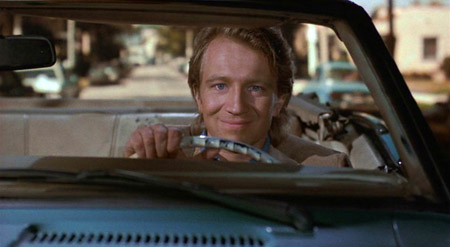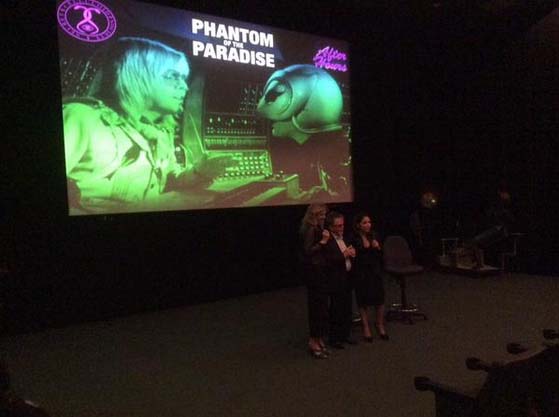'MISSION TO MARS' GETS SOME LOVE & A HALF
IN SEVERAL ARTICLES LOOKING AT SPACE MOVIES, UPON RELEASE OF 'INTERSTELLAR' Brian De Palma
Brian De Palma's
Mission To Mars was loved by several critics when it was released in 2000, making several of their top 10 lists for the year, as well. However, it was also well-hated, and seen mostly as an artistic failure at the time. A new consensus appears to be emerging, however: that
Mission To Mars is a "half-masterpiece" (see
David Edelstein excerpt below), and with the glass half-full, at that, instead of half-empty (even though, of course, we still have the critics referred to above who see a full head-on masterpiece). As
Christopher Nolan's
Interstellar is released in theaters these past few days, several articles are emerging that survey previous space movies, including
Mission To Mars. The bulk of the articles, as one might expect, use Kubrick's
2001: A Space Odyssey as the touchstone. And of course, as expected,
Armond White's review of
Interstellar makes note of De Palma's film (White was one of the aforementioned critics who saw
Mission To Mars as a masterpiece upon its release). Not surprisingly, White is not impressed by
Interstellar, which he calls a "dull, galumphing white elephant" (his review of the film is subtitled "To Insipidness and Beyond").
I myself went into
Interstellar expecting to find it mostly tedious, but I actually loved almost every minute. Perhaps I went with lowered expectations, but I really enjoyed the story and the way it was told. I found it to be a spectacular experience. It may not have quite the visual panache of a Kubrick or a De Palma, or even a Shyamalan, but there are some strong images, and Nolan's film seems informed by all three of those filmmakers, as well as, of course, Spielberg (and I'm sure many others). And
Interstellar seems driven by the same impulse that drove De Palma when making
Mission To Mars: the rekindling of a passionate desire to explore the universe, to think of the big picture, to discover what we're all about.
EBIRI: 'M2M' CREATES "A VISION OF SPACE THAT'S GENUINELY TERRIFYING"
In the first link/excerpt below, critic Bilge Ebiri suggests that Mission To Mars works best, for him, as a silent picture scored by Morricone. Here, with POSSIBLE SPOILERS, are the links/excerpts:
"The 16 Best Space Movies Since 2001: A Space Odyssey"
by David Edelstein and Bilge Ebiri, Vulture
#14 Mission To Mars
Ebiri: Here’s how you watch Brian De Palma’s Mission to Mars. First, you turn off the sound. (If you’re a rabid Ennio Morricone fan like me, you can buy or download the soundtrack and play it over the movie.) Then you turn the whole movie off about 20 minutes before the end. Devoid of the ridiculous dialogue and one of the craziest and most tone-deaf finales I’ve ever witnessed, this is riveting, managing to create a vision of space that’s genuinely terrifying. That’s quite an achievement in an age where visions of space travel on film have become so mundane. De Palma has always been a master of onscreen space — the cinematic kind, not the outer kind — and when he’s given free rein to go to town with his setpieces here, it’s often glorious.
Edelstein: I couldn’t agree more with your advice to stop watching 20 minutes from the end. What upset me about Mission to Mars was its epically dumb finale, which made me dismiss what came before retroactively. (Others did, too: This film is hated.) The thing is, it’s a gorgeous work, alternately intimate and vertiginous, the work of a great filmmaker exploring a new set of variables — ones that take him out of his spatial-temporal comfort zone and induce, as you’ve said, a new kind of terror. The scene in which Tim Robbins removes his helmet in space can hold its own against any human moment in any sci-fi movie. If only we could accept a half-masterpiece.
"YOU'LL BE HARD-PRESSED TO FIND A BETTER-LOOKING SCIENCE FICTION FILM"
Interstellar: Christopher Nolan's Movie Shows Kubrick's 2001 Casts Long Shadow!"
by Brian Finamore, Moviepilot
"Out of a lot of the films in vein of 2001, Brian De Palma's much maligned film Mission to Mars is clearly heavily inspired by 2001. As I mentioned it was savagely criticized by critics for it's somewhat awkward, clunky dialogue. However, you'll be hard pressed to find a better looking science fiction film. The space sequences are visually stunning, and the scenes depicting astronauts on Mars looks as if it was shot on location."
"Interstellar and the top 40 space movies"
Tim Robey, The Telegraph
#32 Mission To Mars
"Brian DePalma's oft-derided foray into space opera has a frankly disastrous finale, but there's some unforgettable stuff in it, especially the mid-film hull breach, foreshadowing Gravity, after which members of the exploration team must desperately grab for a handhold on the outer surface of their resupply module."
"Floating in a Most Familiar Way:
21 Notes About Sci-Fi After 2001: A Space Odyssey"
by Alex Pappademas, Grantland
"Mission to Mars, from the year 2001 [editor's note: actually from the year 2000], becomes Brian De Palma’s 2001 somewhere between Earth and the Red Planet. A tracking shot takes us across the ship’s bow and through a porthole, behind which Jerry O’Connell is modeling a double helix — 'That is the exact genetic composition of my ideal woman' — out of floating M&Ms, and Kubrick’s surveying eye gives way to De Palma’s probing camera. Kubrick gave us a Pan Am spaceflight attendant negotiating a circular corridor with Ford-model poise; De Palma has Connie Nielsen swaying to Van Halen’s 'Dance the Night Away' in zero-G, because BRIAN DE PALMA. And while we’re supposed to feel sad for the astronaut who chooses a one-way ticket at the end of the film, the movie also celebrates his decision to go where no one has gone before; his farewell to humanity is cast not as a heroic sacrifice but as a great ride we’re supposed to take."
"14 Movies to See After You Watch Interstellar"
by Christopher Campbell, Film School Rejects
Sunshine (2007)
"As in Interstellar, the space mission in this Danny Boyle-directed movie is all about saving mankind. Nolan’s version has to do with finding a new residence for the people of a dying Earth while in Sunshine it’s our sun that’s burning out. There are a lot of great reasons to see it, but I mostly recommend it for the performance by Chris Evans, as this was when I realized he was better than the junk he had been starring in. Not that this isn’t a flawed feature, mainly when it comes to a villain in the last act. I felt similarly about the sudden villainy of Interstellar, that I could have done without a bad guy."
Mission to Mars (2000)
"There are even more problems with this Brian De Palma-directed space-mission movie, in which a team heads to the red planet in the hopes that humans can survive there. But its climactic hokeyness has a kind of charm, much like that of Interstellar. Here, sorry to spoil the ending, it’s the meeting of actual Martians, who show the Earthlings that Mars was once habitable until an asteroid hit and they had to evacuate. And we on Earth are the descendants of a 'population bomb' sent to this planet, which is the same method the scientists of Interstellar have planned to further mankind if they can’t save the currently existing human race."
Review of Interstellar: "Nolan gets lost in space"
by Baradwaj Rangan, The Hindu
"It would be easy for Nolan to cash in on his name and keep making sure-fire blockbusters. Instead, he’s made a three-hour film that looks like the love child of Michael Bay and Carl Sagan. And when he wants, he can be an amazing filmmaker. The most stunning stretch of Interstellar, for me, was when Cooper, having decided to go to space, drives away from his home and, as he is driving away, we hear the T-minus countdown, and we cut directly to the space shuttle blasting off. We’ve already spent a good amount of time knowing this man and his love for space travel, and we don’t need any more scenes in between. This is dramatic, economical storytelling.
"But why is it absent elsewhere? Why is there so much flab? Why — when compared to, say, Gravity — are there so few visuals that are truly mind-bending, like the shot of a corpse floating in the sea, or the grave sight of the burnt-out parts of a space station? Looking at the zero-gravity sequences here, I was reminded of Brian De Palma’s Mission to Mars — not a great movie, but it certainly had a great stretch where a character cut himself and the blood streaming out formed wondrous patterns, and later, the leads performed a playful waltz in these conditions. Maybe it’s time Nolan rediscovered some of the breathless playfulness he so wickedly unleashed in The Prestige."
Review of Interstellar: "To Insipidness and Beyond"
by Armond White, National Review Online
"Interstellar never explores colonization, good vs. evil, or metaphysics — not even when Coop gives a watch to his petulant daughter Murph (Mackenzie Foy); she tosses the memento in anger, not faith like the rejection of Time in Borzage’s great spiritual tearjerker Three Comrades. Nolan’s parent-child premise becomes a Benjamin Button farce (with Ellen Burstyn reprising her cameo as old Murph from the seniors doc at another point in the film). It lacks the cross-generational, cross-time resonance of that good Jim Caveziel–Dennis Quaid film, Frequency. Brian De Palma’s outward-looking cosmos-politan affirmation in Mission to Mars gets refuted by Nolan’s nuclear-family solipsism. And at the crucial juncture when adult Murph’s (Jessica Chastain) last-ditch efforts to save her family are contrasted with Coop’s, Nolan forgets to intercut the two stories, dragging out another hour. So long panache, adios to 'genius.'
"Critics who follow weak praise for Goodbye to Language with hosannas for Interstellar are disingenuous. You can’t celebrate Godard’s rigorous, ecstatic examination of art and morality and then lead audiences to Nolan’s trite, overblown, unbeautiful, and non-resonant epic. One’s for movie-lovers, the other’s for sheep. When Godard says goodbye to language, the culture represented by Interstellar is what he means."
 BAMcinématek in Brooklyn began a "Sunshine Noir" film series last night (Wednesday) with a screening of William Friedkin's To Live and Die in L.A. Brian De Palma's Body Double is included in the series, and will screen this Tuesday, December 2nd. The series "explores what happens when noir steps out of the shadows and into the neon-lit boulevards of LA," according to the BAM website. "Burrowing beyond the glitz and glamour of Tinseltown, these hard-boiled tales of outsiders and antiheroes expose the seedy underbelly of the City of Angels." There are almost too many great movies in the series to name them all here, but today and tomorrow, Roman Polanski's Chinatown will play, and on December 8 will be Paul Thomas Anderson's new film, Inherent Vice.
BAMcinématek in Brooklyn began a "Sunshine Noir" film series last night (Wednesday) with a screening of William Friedkin's To Live and Die in L.A. Brian De Palma's Body Double is included in the series, and will screen this Tuesday, December 2nd. The series "explores what happens when noir steps out of the shadows and into the neon-lit boulevards of LA," according to the BAM website. "Burrowing beyond the glitz and glamour of Tinseltown, these hard-boiled tales of outsiders and antiheroes expose the seedy underbelly of the City of Angels." There are almost too many great movies in the series to name them all here, but today and tomorrow, Roman Polanski's Chinatown will play, and on December 8 will be Paul Thomas Anderson's new film, Inherent Vice.



 Ute Bergk, the set decorator on Brian De Palma's Passion, was interviewed recently by
Ute Bergk, the set decorator on Brian De Palma's Passion, was interviewed recently by 


 An article today by Shelly Davidov at the
An article today by Shelly Davidov at the  Brian De Palma's Phantom Of The Paradise will be screened this Saturday night at 11:30pm at the
Brian De Palma's Phantom Of The Paradise will be screened this Saturday night at 11:30pm at the  While in Rome shooting All Roads Lead To Rome, producer Silvio Muraglia told
While in Rome shooting All Roads Lead To Rome, producer Silvio Muraglia told  Sc Mira, a musical act from Winnipeg made up of Sc (Stephanie Catherine) and Tyler Wagar, released a Halloween-themed mixtape last month made up of three songs, including two Paul Williams-penned numbers from Brian De Palma's Phantom Of The Paradise: "Somebody Super Like You" and "Life at Last." You can listen to the mixtap, titled Candy Apples and Razor Blades, via the YouTube video embedded below. The third song is a cover of the Misfits' "Halloween."
Sc Mira, a musical act from Winnipeg made up of Sc (Stephanie Catherine) and Tyler Wagar, released a Halloween-themed mixtape last month made up of three songs, including two Paul Williams-penned numbers from Brian De Palma's Phantom Of The Paradise: "Somebody Super Like You" and "Life at Last." You can listen to the mixtap, titled Candy Apples and Razor Blades, via the YouTube video embedded below. The third song is a cover of the Misfits' "Halloween." The CW series Supernatural aired its 200th episode last night, and presented it as a musical. Series writer and producer Robbie Thompson tells
The CW series Supernatural aired its 200th episode last night, and presented it as a musical. Series writer and producer Robbie Thompson tells  Brian De Palma's Mission To Mars was loved by several critics when it was released in 2000, making several of their top 10 lists for the year, as well. However, it was also well-hated, and seen mostly as an artistic failure at the time. A new consensus appears to be emerging, however: that Mission To Mars is a "half-masterpiece" (see David Edelstein excerpt below), and with the glass half-full, at that, instead of half-empty (even though, of course, we still have the critics referred to above who see a full head-on masterpiece). As Christopher Nolan's Interstellar is released in theaters these past few days, several articles are emerging that survey previous space movies, including Mission To Mars. The bulk of the articles, as one might expect, use Kubrick's 2001: A Space Odyssey as the touchstone. And of course, as expected, Armond White's review of Interstellar makes note of De Palma's film (White was one of the aforementioned critics who saw Mission To Mars as a masterpiece upon its release). Not surprisingly, White is not impressed by Interstellar, which he calls a "dull, galumphing white elephant" (his review of the film is subtitled "To Insipidness and Beyond").
Brian De Palma's Mission To Mars was loved by several critics when it was released in 2000, making several of their top 10 lists for the year, as well. However, it was also well-hated, and seen mostly as an artistic failure at the time. A new consensus appears to be emerging, however: that Mission To Mars is a "half-masterpiece" (see David Edelstein excerpt below), and with the glass half-full, at that, instead of half-empty (even though, of course, we still have the critics referred to above who see a full head-on masterpiece). As Christopher Nolan's Interstellar is released in theaters these past few days, several articles are emerging that survey previous space movies, including Mission To Mars. The bulk of the articles, as one might expect, use Kubrick's 2001: A Space Odyssey as the touchstone. And of course, as expected, Armond White's review of Interstellar makes note of De Palma's film (White was one of the aforementioned critics who saw Mission To Mars as a masterpiece upon its release). Not surprisingly, White is not impressed by Interstellar, which he calls a "dull, galumphing white elephant" (his review of the film is subtitled "To Insipidness and Beyond").